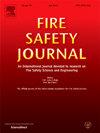基于区域模型理论的初始燃料深度对密闭室内池火燃烧效率的影响研究
IF 3.4
3区 工程技术
Q2 ENGINEERING, CIVIL
引用次数: 0
摘要
本文通过实验研究了初始燃料深度对密闭室内池火燃烧效率的影响。实验中进行了三种不同大小的池火。得到了不同初始燃料深度下密闭舱内池火的燃烧速率、烟温分布和氧浓度等燃烧参数。结果表明:不同初始燃料深度的池火会出现两种典型的熄灭模式:燃料燃尽和缺氧自熄。封闭隔间内池火的整个燃烧过程可分为以下五个阶段:快速上升阶段、过渡阶段、稳定燃烧阶段、沸腾燃烧阶段和熄灭衰变阶段。燃烧速率的最大值和平均值与初始燃料深度呈幂函数关系。氧浓度的消耗主要受初始燃料深度、池大小和舱室容积的影响。采用氧浓度的无因次表征来表征密闭隔间内的灭火行为。此外,基于燃烧过程和消光行为,在考虑密闭室初始燃料深度的情况下,提出了池火的全局燃烧效率来预测其燃烧特性。本文章由计算机程序翻译,如有差异,请以英文原文为准。
The impact of initial fuel depth on the combustion efficiency of pool fire in an enclosed compartment: A study based on zone model theory
In this paper, the effect of initial fuel depth on the combustion efficiency of pool fires in an enclosed compartment was experimentally studied. Three different sizes of pool fires were conducted in the experiments. Several combustion parameters including burning rate, smoke temperature distribution, and oxygen concentration of pool fires under the different initial fuel depths in closed compartments were obtained. Results showed that the pool fire with the different initial fuel depths would appear in two typical extinction modes: fuel burning out and self-extinction due to lack of oxygen. The whole burning process of the pool fire in the enclosed compartment can be divided into the following five stages: rapid rise stage, transition stage, stable combustion stage, boiling combustion stage, and extinguishing decay stage. The maximum and average values of the burning rate presented the power function of the initial fuel depth. The consumption of oxygen concentration in the compartment was mainly affected by the initial fuel depth, the pool size, and the compartment volume. Dimensionless characterization of the oxygen concentration was adopted to characterize the fire extinction behavior in the enclosed compartment. In addition, on the basis of the combustion process and the extinction behavior, a global combustion efficiency of pool fire was proposed to predict the combustion characteristic while considering the initial fuel depth in the enclosed compartment.
求助全文
通过发布文献求助,成功后即可免费获取论文全文。
去求助
来源期刊

Fire Safety Journal
工程技术-材料科学:综合
CiteScore
5.70
自引率
9.70%
发文量
153
审稿时长
60 days
期刊介绍:
Fire Safety Journal is the leading publication dealing with all aspects of fire safety engineering. Its scope is purposefully wide, as it is deemed important to encourage papers from all sources within this multidisciplinary subject, thus providing a forum for its further development as a distinct engineering discipline. This is an essential step towards gaining a status equal to that enjoyed by the other engineering disciplines.
 求助内容:
求助内容: 应助结果提醒方式:
应助结果提醒方式:


